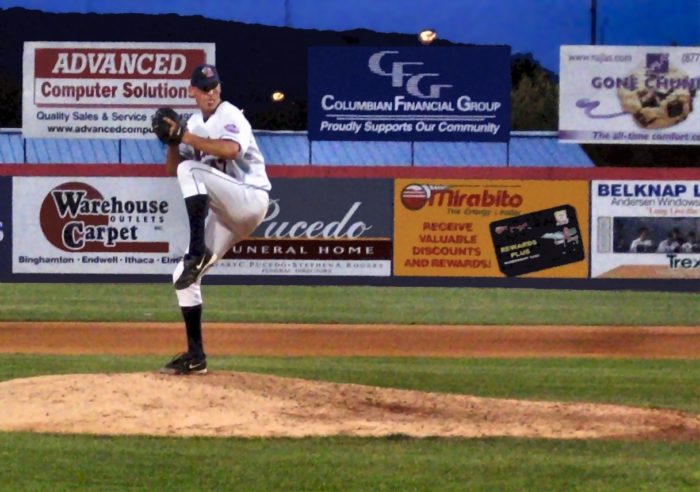
Earlier this week the 34-year-old Mike Pelfrey retired from Major League Baseball and is now a coach Newman University.
Pelfrey spent the peak of his career as a mainstay in the New York Mets rotation, after being quickly summoned to the big leagues at age 22.
From 2008-2011, Pelfrey would offer around 200 innings in each of those four seasons. While two of those seasons were quite good (3.2 WAR in 2008 and 2.5 WAR in 2010), those were Pelfrey’s only seasons as a Met that produced significantly positive production. Will he be remembered in a mostly positive light? Or will he be rued for what could have been? That is open for interpretation, but it begs a look at what the expectations were for Pelfrey as he made his foray into a life in professional baseball.
Pelfrey was nabbed by the Mets under the Omar Minaya regime as the ninth overall selection in the 2005 Amateur Draft. Pelfrey was easily regarded as the top pitching talent in the country after dominating for three years at Wichita State University.
The Mets were able to draft Pelfrey as late as they did due to signability concerns, as Scott Boras was his agent. Lo and behold what difference a decade makes, as the Mets back then put forth the financial clout needed to sign Pelfrey to a Major League deal for $3.55 million.
So Pelfrey began his professional career in 2006 and raced through the Mets system, making his big league debut that very year. Pelfrey would spend some time in the Pacific Coast League in 2007, but was up for good in 2008 after accumulating 204 minor league innings.
Looking back, his time in the PCL in 2007 could have been a harbinger of the type of pitcher Mike Pelfrey would become. That, though, did not pair with the lofty expectations of a future ace.
From a scouting standpoint, Pelfrey was so coveted as an amateur due to his 70-grade fastball. A two-seamer with sink that Pelfrey could run up into the mid 90’s, the 6’7 right-hander relied on it’s plus extension and downward plane to induce groundballs at an exemplary rate.
Throughout his career, Pelfrey ran HR/9 rates consistently between 0.5 and 1.0. But the one key piece missing from Pelfrey’s repertoire was that change of pace breaking pitch that could induce swings and misses.

As Pelfrey rode the buses through the Florida State League and the Eastern League, his fastball alone was dominant enough to garner swings and misses. In his first professional season, Pelfrey struck out 109 in only 96 innings across those two levels. The hope for such a young pitcher with a mechanically sound delivery was that Pelfrey would learn to hone a slider into a major league quality breaking pitch that could produce significant swings and misses. But perhaps the largest lesson here in prospect evaluation, is that such things are sometimes easier said than done.
In 2007, Pelfrey spent most of his season pitching for New Orleans, the Mets Triple-A affiliate in the notoriously hitter-friendly PCL. Against the top echelon of minor leaguers that year, Pelfrey would strike out only 56 in 74 innings.
So became the story for Pelfrey’s entire career. Even during his peak stretch, Pelfrey never struck out more than 5.2/9 in a given season. Though Pelfrey maintained his ability to create groundballs, a terrific skill for a pitcher, not pairing that ability with a legitimate breaking pitch lead to too much loud contact throughout his career. Even during his peak, before he succumbed to Tommy John Surgery in 2012, Pelfrey consistently posted high WHIPs (1.36 and 1.37 even in his best 2008 and 2010 seasons).
I’d like to draw some parallels here to some of our current favorite Mets prospects. What if Pelfrey learned the Warthen slider (en vogue with the Mets just after Pelfrey left the organization)? Would he have turned into the Dark Knight before there was one? Then again, Warthen came aboard during the end of Pelfrey’s time here, and Pelfrey was known to have been working on a hard slider for good reason. Was the pitch, blamed by some for creating too much stress on the elbows of Harvey, Matz et al., part of the cause of Pelfrey’s own torn UCL in 2012? We can never know for sure. But there is every reason to believe that such a weapon would have transformed Pelfrey into something more.
When we look at exciting Mets prospects that have room to grow as pitchers, perhaps Pelfrey can shed some light on what outcomes can occur. Nobody knows how easily Anthony Kay will be able to fix the telegraphing of his otherwise plus changeup. Nobody knows if Justin Dunn will learn to consistently repeat his arm slot, and allow his plus repertoire to play up to it’s potential.
As much reason as there is to be excited for 2017 first round pick David Peterson, Pelfrey’s career can teach us that being a first round pick does not a top pitcher make. As anticlimactic as this may seem for us fans who love to dream on prospect potential, if any of these pitchers individually have the Mets career that Pelfrey did (multiple > 2 WAR seasons), it could be considered a success.
So what say you? Was Pelfrey a good Met? A mild disappointment? Even a bust? As do many things in the prospect world, the answer lies in the eye of the beholder.


Most of the 1st rounders don’t become stars. I say from the expectations: A mild disappointment. Having a nice Fastball and a 90s plus sinker but he never was a strikeout guy. He had 2 good seasons and quite a bit of mediocre ones.
Then looking at that draft he was in some will look at Jacoby Ellsbury, McCutchen, Jay Bruce who were drafted in that round that become stars and yes they could’ve helped Mets more but that’s just hindsight. This was a good pick at the time. He was just Big Pelf, never knew what you’d get from him. I hope guys like Kay, Peterson, Dunn all college pitchers have a better career than Pelf.
In some ways Rick Peterson was the wrong coach for Pelf. From what you’d read Peterson talked like a nuclear scientist, way above Pelf and many pitchers during those days. Pelf sure had some great stretches too bad.
Starting a statement with, “Most of the 1st rounders..” is always a mistake because its too generic. There’s a huge gap between the success rates of players taken earlier in the round and those taken later. Pelfrey was taken early. And he was projected to be a #2 pitcher. He turned out to be considerably less than that.